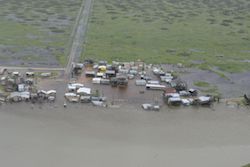SEJournal Online is the digital news magazine of the Society of Environmental Journalists. Learn more about SEJournal Online, including submission, subscription and advertising information.
TipSheet: Harvey Uncovers Flood Insurance Dilemma
With the wreckage of Hurricane Harvey in the news and a September 30 deadline looming, Congress is set to gamble with tax dollars and U.S. neighborhoods as it tries to fix the National Flood Insurance Program.
The NFIP provides tax-funded federal backing for “federal” flood insurance sold by private companies. The condition is this: To be eligible, communities must keep development out of the floodplain and have a floodplain management program. Everybody else pays prohibitive premiums if they can get flood insurance at all.
The NFIP is pretty much the only provider of most flood insurance, especially for homeowners, because few insurers want to offer it at rates people can afford.
And the program is … well, if not “bankrupt,” then in debt right now for around $25 billion. That amount could go way higher once the full bill for Harvey is known. Premiums are not paying for the losses we have seen in recent storm events like Sandy and Katrina, and the government takes up the slack by borrowing.
Authorization for the NFIP runs out at the end of the month, and Congress has been deadlocked on how to fix the program for a long time. Hurricane Harvey will create huge pressure to do something — if only to kick the can down the road.
The NFIP reauthorization will likely get bound up politically with Harvey relief aid, the debt ceiling, an appropriations omnibus and maybe even President Donald Trump’s border wall and a government shutdown. It will be a news crunch — but that is not the subject of this TipSheet.
Is there a flood insurance story near you?
Flood insurance is a great local and regional story for enterprising environmental journalists because it affects people’s lives.
 |
|
Hurricane Harvey-damaged homes on the Texas coast, southwest of Houston between Port Aransas and Port O'Connor. Photo: U.S. Coast Guard/Johanna Strickland. |
Fact: Only about one-fifth of the families who lost their homes in Harvey had flood insurance. The rest will either lose their homes or face huge costs to rebuild.
Families face similar risk in many other parts of the United States. Not all the flood risk comes from tropical storms; it also comes from other kinds of storms, seasonal snowmelt, rivers, estuaries and sea-level rise.
Finding risky areas is not too hard for those who look — because the Federal Emergency Management Agency (which houses the NFIP) has pretty good data and makes it public. FEMA’s flood maps are all accessible online from a single search engine, found here.
Manipulating and understanding the maps, however, can be tricky. You have to take account of revisions. It helps to be handy with GIS software.
Translating the floodplains into insurance policies is even harder. You may want to consult experts — whether county floodplain officials or insurers — for interpretation.
Check to see if your county or counties have a floodplain management program. This is usually a regularly listed part of county government — when it exists.
Also check in with your county’s zoning and planning departments, if you have them. Zoning requirements are one way to control building in the floodplain.
Not every county believes in this zoning stuff; some see it as a government power grab, stealing the private property of free Americans. Such was essentially the case in Harris County, Texas, where Houston is. That, many say, made the storm Harvey disaster worse.
Lack of restrictions on where people can build, of course, is not the only cause of the disaster. Record rains, low topography and obsolete drainage helped.
Floodplain management agencies exist at the state level, too. In some states, several agencies are involved in things like issuing permits, managing waterways or managing stormwater.
Each state is unique, but if you search your own state’s agencies, you should be able to outline the structure of what agencies need to be involved in your state’s floodplain management program.
Floodplain managers, other information sources
An important clearinghouse for information is the Association of State Floodplain Managers. The ASFPM actually certifies floodplain managers, so if you think you have found an expert, ask whether they are certified.
The NFIP is often failing to meet its goal of keeping people out of the floodplain. After NFIP pays for losses, some home and business owners rebuild in the same place. These are called “severe repetitive loss” — and these insured parties, who are only a small percent (about 1 percent) of policy holders, account for a major share (25-30 percent) of total claims.
Media often drive the narrative of the plucky homeowner determined to rebuild. It may be short-sighted. Can you identify repetitive loss claimants in your area? Addressing repeat loss is one target of NFIP reform.
Some further information sources include Pew Charitable Trusts, the Insurance Information Institute, the Government Accountability Office, and local realtors and mortgage lenders. And, of course, FEMA’s NFIP has huge amounts of good basic information.
Editor's Note: For more of SEJournal's coverage of Hurricane Harvey and hurricane-related reporting, including Toolboxes, TipSheets and Backgrounders, visit our compilation page.
* From the weekly news magazine SEJournal Online, Vol. 2, No. 33. Content from each new issue of SEJournal Online is available to the public via the SEJournal Online main page. Subscribe to the e-newsletter here. And see past issues of the SEJournal archived here.












 Advertisement
Advertisement 



